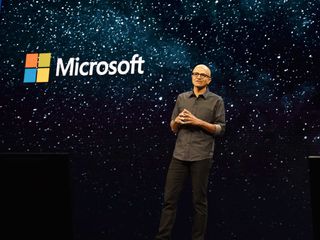How Surface and Azure are making Microsoft experiences 'best on Windows'
Microsoft's CEO Satya Nadella promised the best Microsoft experiences would be on Windows. Surface and Azure may make good on that promise.

Microsoft's iOS and Android cross-platform investments and platform-agnostic dev-box positioning have been at the forefront of recent news coverage. A ubiquitous computing mission led by Azure as "the world's computer" has also drawn attention to Microsoft's investments beyond Windows.
In a multi-device, multi-ecosystem personal computing world dominated by mobile platforms Windows is no longer the dominating force. To keep Windows relevant Microsoft is making it part of the "connective tissue" binding user experiences across ecosystems and devices. Though iOS and Android dominate mobile most people use Windows PCs for desktop computing.
Thus, Android, and iOS integration with Windows via Timeline, Sets, Your Phone, Android Launcher, Cortana, Microsoft Graph, Microsoft 365 and more is vital to Microsoft's mission.
Still, Windows as a computing platform where Microsoft's services shine on first-party Surface and HoloLens hardware, and partner Windows devices is Microsoft's goal.
Devices and Services
In 2013 former Microsoft CEO Steve Ballmer shared Microsoft's (pre-cloud and AI) "devices and services" mission:
No technology company has...delivered a definitive family of devices useful all day for work and…play, connected with every bit of a person's information available through one cloud. Our family will include a full spectrum of … partner and first-party devices…and other devices to be imagined and developed.
That vision, affected by struggling smartphones and two failed Surface attempts, wasn't realized during Ballmer's tenure. Not until Surface Pro 3's 2014 launch did Microsoft's hardware efforts beyond Xbox start reflecting that vision.
How Surface changed Microsoft forever
Get the Windows Central Newsletter
All the latest news, reviews, and guides for Windows and Xbox diehards.
Surface rising
Surface Pro 3 finally struck the balance between content creation and consumption and context conformity, that exemplified the "device that is useful for work and play" Ballmer expressed as the goal of Microsoft's device family.
Corporate vice president for Surface Panos Panay demonstrated how OneNote, Surface, Surface Pen and cloud worked together from initiating OneNote with the click of the pen, to writing on the screen, to saving to the cloud. Though OneNote is available on other platforms, the experience isn't as complete as with Surface and Windows.
Surface Book, Surface Laptop, Surface Studio and Surface Hub make Microsoft's Office, Whiteboard, Edge, and more shine in a way they can't on non-Windows hardware. Touchscreens on most modern Windows PCs and all Surface devices, combined with Windows Ink and integrated Cortana allow for a natural, immersive and collaborative experience that can't be had on non-touchscreen devices like MacBooks running Microsoft apps.
Nadella explained Microsoft's hardware investments are to bring all the company's cloud infrastructure, application services, and hardware capabilities to a user's digtal experiences.
Surface collaboration through Azure
In 2016 I wrote about Microsoft's "you are the hub" Windows 10 devices strategy. Microsoft's device family was introduced as a collaborative hardware platform with user experiences at the center moving seamlessly across devices via a common platform.
For example, though Azure supports cross-platform collaboration, team members using Microsoft tools via Windows on Surface Hub, Surface Pro, HoloLens and the rumored Andromeda digital journal, would have a richer touch and inking experience, with more options, than someone using an iPhone or MacBook.
Microsoft's hardware initiative is meant to spark interest in its entire ecosystem. Surface Pro inspired an industry of 2-in-1s and expanded access to Microsoft's ecosystem via what is now the only growing PC segment.
Microsoft is building inking into a collaborative enterprise environment
Innovative PCs












Devices like Intel's, Lenovo's and Asus' recently introduced dual-screen PCs show how versatile Windows is across form factors. Writing on an electronic paper display (EPD) and uploading the content to OneNote on the connected LCD as is possible with Intel's Tiger Rapids concept dual-screen PC, also demonstrates the ecosystems investments in a "best on Windows" Microsoft experience OEMs can emulate.
Additionally, Windows Core OS, as seen with Surface Hub 2, enhances user experiences by conforming to context. Windows Core OS is also reported to power Microsoft's rumored folding Andromeda pocket PC allowing it to transition between mobile, tablet and desktop scenarios. As a pocketable Windows PC, iOS and Android integration could keep users engaged in Windows as they field smartphone alerts from this device as is possible with other Windows 10 PCs with features like Your Phone. iOS and Android integration on present and future Windows PCs is another way Microsoft is creating best on Windows Microsoft experiences.
Surface and cloud synergy has begun making good on Nadella's best on Windows promise, and though there's a long way to go expanding hardware categories and Always Connected PCs, with unique Windows experiences will likely continue that trend.
Jason L Ward is a columnist at Windows Central. He provides unique big picture analysis of the complex world of Microsoft. Jason takes the small clues and gives you an insightful big picture perspective through storytelling that you won't find *anywhere* else. Seriously, this dude thinks outside the box. Follow him on Twitter at @JLTechWord. He's doing the "write" thing!
